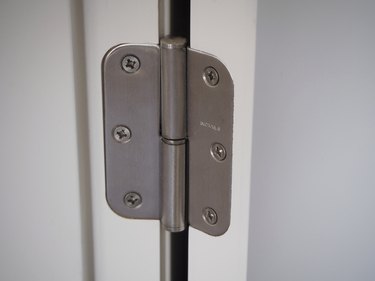A self-closing hinge is a closure for a door or cupboard with an automatic closing mechanism. They're useful because they keep doors and cupboards closed and help avoid disruptive slams. But once they no longer work automatically, they will need to be either adjusted or removed and replaced.

Installing A Self-Closing Hinge
First, place the hinges onto the door. See if they line up with the nail indents from the previous hinges. If the holes align, you can simply attach the hinge using the screws it came with. If not, map out the new holes using a pencil.
Video of the Day
Video of the Day
Drill new pilot holes using a drill bit smaller than the screws you will be using to attach the hinge. Aim to make holes about half an inch deep. Then, screw in the hinges to the door frame.
You can then attach the door to the hinges following the same steps.
Adjusting A Self-Closing Hinge
Determine the adjustment needed by attempting to close the door. If it closes too quickly or violently, the hinge will need loosening. If it does not fully close, the hinge will need tightening.
To loosen, first close the door. Find the hole beside the locking pin on the hinge's spring, which is usually either at the top of bottom of the hinge's housing. Rotate the locking pin to remove, and replace the pin one hole further away from the door. Release the spring pressure and test the closure of the door. If it is still slamming shut, repeat the process and move the pin another hole away from the door.
To tighten a hinge, you will also need the door closed. Following the same process used for loosening, you will instead want to move the pin one hole closer to the door. Test the closure to see if the door is now shutting fully. If not, move the pin another hole closer until it does.
If you follow these steps and are still unhappy with your hinge, you can either try lubricating it or replacing the spring completely as it may be worn out.
Removing A Self-Closing Hinge
First, you need to remove the cover plate in order to see the mechanism of the spring. See if the hinge has a tension adjuster. The adjuster will look like a small cap at the base of the hinge pin, with hole all around to allow tension to be adjusted. If your hinge has this feature, adjust the tension to as low as possible.
Clamp the hinge open, preferably using a C-clamp, so you have access to the hinge's screws. If you don't have one, you can use a hammer, although this method is significantly more risky. Remove the screws from the hinge using a screwdriver, leaving the middle screws until last. Be very careful to resist putting your fingers anywhere near the hinge at this stage.
As you remove the final screw, the clamp will snap shut. Be prepared for the force of the spring. Once it is closed, you can remove the clamp and hinge.